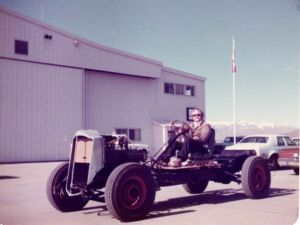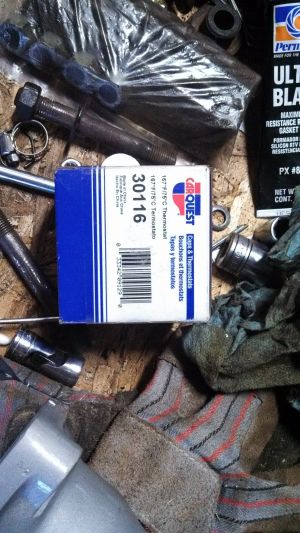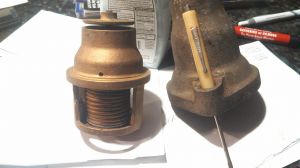- Home
- About Us
- Join/Renew
- Member Benefits
- Member Pages
- Log In
- Help
- Museum Store
Over the years there has been discussion in the PASB’s about adding a thermostat. Does anyone have any words of wisdom regarding running an 8 with a thermostat? If so, what thermostats fit?
My question is short term. I am only thinking of doing it temporarily for the initial start, ring seating and shakedown runs until the shutters and radiator shell get installed. Years ago I put in quite a few miles on my Packard’s bare chassis trying to control the temperature with cardboard blocking the radiator and created some serious carbon fouling that didn’t do the engine any good. The picture is circa 1983.
Thanks, Jim

I have a regular auto thermostat in my eight. I wouldn’t run without it. It brings the engine temp quickly and holds the temp. right at the mid range.
I don’t know what number Stant thermostat I used but it fits right into a grove in the hose neck that attaches to the head with two cap screws. I think I used a 160 degree thermostat. If your shutters don’t work this is a good way to run your engine at a proper temperature.
It is better for the engine than running the engine too cold. If you take the neck to an auto store you should be able to easily find one that fits.
My 2 cents worth.
Cal Dyke
Adding to Calvin’s great points, Restoration Supply has inline T stat’s at both 1-1/2 and 2″ diameter-they are rated 160F.
John”
Hi Jim, I like to run a thermostat in the water neck on the cylinder head, even when the factory thermostat and shutters are working properly.
My reasoning is that with an in-hose wet thermostat, the greatly reduced flow rate of water circulating through the engine will let the engine come up to temperature much, much faster. And as you mentioned, running an engine cold, and especially a fresh engine cold is very detrimental to the seating of the rings, and overall break-in of the engine.
The most important issue with using an in-hose wet thermostat in either the Series 80.81 six cylinder engines or the ’29 and later 8 cylinder engines is that they do not have any form of a bypass water passageway. A thermostat can completely block all circulation of coolant in the engine.
With no circulation of coolant in the engine, the coolant cannot move the heat from the hot spots around the exhaust valves, the top of the combustion chamber, and the top few inches of the cylinders. These areas will quickly boil the coolant that is in contact with the hot spots. But since there is no circulation, the thermostat is not in a ‘hot spot’ and will not be open. So, the engine has areas that are badly overheating, and soon the boiling coolant will flash to steam and force it’s way to the thermostat, when it opens, a rush of cold or cool water from the radiator circulating through the overheating engine..
This is NOT a good situation.
What works very well, is to drill two 1/8″ diameter holes through the flat plate around the outside of the thermostat. This small bypass is enough to allow enough circulation to equalize the hot and cool spots in the engine, and allow the thermostat to smoothly regulate the coolant temperature.
Most Pierce cooling systems benefit from slowing down the circulation rate of coolant. The coolant circlates so fast that it tends to foam unless it’s pure water. And even pure water will tend to flood the upper tank of the radiator, and be pushed out the overflow tube. Slowing of the circulation rate of the coolant reduces or stops the water being pushed out the overflow tube. The thermostats I use reduce the flow rate enough to stop the loss of coolant.
The photo shows the thermostat that I use in Series 80/81 engines.
Greg Long

Greg,
Thanks for that explanation. I wondered why when I used coolant it foamed and pushed out the overflow tube, but when I used pure water (with a rust inhibitor), I saw no foaming, and the water level remained constant throughout the driving season.
Robert
I don’t use a thermostat, but don’t drive much in very cold months either.
It’s a huge debate that I’ve seen, but slowing down the coolant flow is very beneficial. I’ve seen the debate get to the atomic level, saying that the atoms of the cooling media get more time to absorb and transfer heat, but that’s all conjecture. I know what works…
I used to drive my car at speed, and when I took my foot off the accelerator, water would spew out the radiator. Simply, the flow of water was too great to the top of the radiator, it didn’t “shut off” when the engine went to lower revs, the momentum of the water flow didn’t stop and the water pump just pumped too much water.
I took a freeze plug that fits the top radiator hose, drilled a 5/8 inch hole in it, and inserted it right at the top of the hose. Problem solved. Engine heats up to operating temperature quickly, no water overflow if decelerating, and car runs cool.
I prefer this method to an inline thermostat in a car that wasn’t designed for same (i.e. no bypass).
Pierce understood the need for a coolant bypass to allow some circulation during warm up. Pictured here is a very rare original equipment Series 80 thermostat. It is made of cast brass, and it’s shape dictated the shape of the lower end of the water outlet neck.
The thermostat is just short enough to not touch the inside of the cylinder head.
Please note the 1/8″ diameter hole in the casting just above the large squared-off ring around the middle.
There is a matching 1/8″” hole in the other side of the thermostat housing.
Greg Long”

Another view of the water-outlet neck with the thermostat seated inside. Even with rather extensive corrosion in the aluminum water neck, the thermostat is a pretty good fit in the recess.
BTW: If anyone is planning on removing and replacing the water neck on a Series 80/81, you must NOT use any form of thick, soft gasket between the water neck and the cylinder head. The two studs that locate and hold the water neck in place are also head studs, holding the cylinder head tight to the cylinder block and clamping the head gasket. The torque on the 7/16″-20 studs is 45-50ftlb.
If a thick gasket is used under the water neck and thermostat, when the head studs are tightened, the gasket will crush very easily directly under the studs, but won’t crush very much around the rest of the gasket surface. The result is the two ears under the head nuts and washers bend down, and crack the water neck base. This is why so many water necks have been welded or replaced with a non-original neck.
Since our Pierce cars do not have a pressurized cooling system, the gasket at the base of the water neck only has a few ounces of water pressure inside. This means that the bare minimum of gasket sealer on both surfaces will seal the water passageway. If a gasket must be used, I’ve used a 3″x5″ index card, or even a piece of typing paper along with a careful application of Permetex Ultra-Black RTV gasket sealer. I just make sure all surfaces are dry and free of oils. A thin layer is rubbed into any imperfections in the surfaces, then the surfaces joined and head studs/nuts torqued. Let it set for a few hours before filling with water/Penncool or your favorite coolant mix.
When installing a modern thermostat in a Series 80/81, Use a large ‘O’ ring that fits snugly in the recess in the neck, install the thermostat first, then use the O-ring to hold it in the neck, use a thin coating of sealant on the base of the neck and the O-ring, as well as on the head’s gasket surface.
When installing the water neck on an 8-cylinder car, the bolts holding the neck are not head bolts, and are a smaller thread size. They only need to be tightened to ‘snug’.. around 20ftlbs. Here again, if an overly thick gasket is used, and too much tightening pressure on the bolts, the ears of the water neck will crack.
Greg Long

I have read these accounts in the PASB about restricting the flow to keep from foaming and dumping coolant out of the overflow, I guess that hasn’t changed. I will add a thermostat and drill some holes as suggested.
Thanks for the responses!
The debate about how an engine can counter-intuitively run cooler by restricting the flow doesn’t really depend on looking at an atomic level. It depends on the heat balance between the engine adding heat to the coolant versus the ability of the radiator to remove the heat. Basic convective heat transfer says that increasing the velocity of the flow increases the heat transfer rate from the hot engine surfaces to the coolant. More heat is transferred but the temperature rise of the coolant will be less because more coolant is flowing. The radiator’s ability to reject the heat added to the coolant by the engine is limited by the amount of air passing through the radiator – a perfect radiator can’t reject any more heat once it raises the air temperature passing through it to the coolant temperature. Thus, if the radiator is close to capacity on the air side the coolant temperature can rise with more coolant flow.
Regardless, restricting the flow through the engine can reduce the overall temperature of the coolant but reduced velocities can make local hot spots more likely that can turn into steam pockets – so I am a little leery of taking this too far.
The goal is not to reduce the temperature of the engine but to keep it at the right level. The cylinder barrels actually tend to run cooler than ideal, and it would be better to keep the scale and rust on them to reduce the heat transfer from them if one could guarantee the junk wouldn’t flake off and plug the radiator!
Note that an engine that has been bored and had the cylinder head surfaces machined has thinner walls allowing more heat transfer through those surfaces, and will slightly increase the tendency towards overheating.
As mentioned above one of the biggest concerns is avoiding local hot pockets particularly under the exhaust valves. Prestone doesn’t have as much heat capacity as water, but it raises the boiling point to help suppress steam, and that is why engines can live a healthy life on water/glycol mix.
Jim
The debate that I referenced about taking it to the atomic level used the example of taking one atom of water (or more precisely one unit of H2O)and discussing how many times it was able to take and reject heat as it passed slower or faster through the engine. Sort of silly.
Foaming was mentioned above, except when running pure dihydrogen monoxide. The water pump must have a good seal, it can draw air into the system which can cause foaming.
Interesting discussion.
